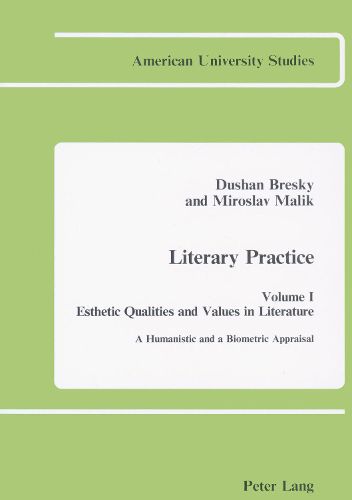Readings Newsletter
Become a Readings Member to make your shopping experience even easier.
Sign in or sign up for free!
You’re not far away from qualifying for FREE standard shipping within Australia
You’ve qualified for FREE standard shipping within Australia
The cart is loading…






Literary Practice I is the first volume of a critical trilogy. (Vols. II, Esthetic of Style, and III, Esthetics of Literary Subjects, are soon to follow.) This seminal work marks an unprecedented collaboration between critic-humanist and a bio- cybernetist, developing two independent yet complementary methods of evaluating literary art. Critic Bresky identifies textual stimuli in subject matter and style, recording both their density and fluctuating intensity within the microcontext. His graphical synthesis provides the base for a broad assessment of the macrotext. For scientific substantiation of his humanistic approach, Bresky invites biocybernetist Malik, to measure the physiological energy changes related to the critic’s -sentic- perception of the text. The resulting biometric profile parallels Bresky’s resume of stimuli. Contemporary theorists will find this joint exploration by a humanist and a scientist both original and controversial. It not only challenges the long domination of bloodless academic theoretism, it uses modern techniques to reassert the traditional goals of literary practice and criticism.
$9.00 standard shipping within Australia
FREE standard shipping within Australia for orders over $100.00
Express & International shipping calculated at checkout
Literary Practice I is the first volume of a critical trilogy. (Vols. II, Esthetic of Style, and III, Esthetics of Literary Subjects, are soon to follow.) This seminal work marks an unprecedented collaboration between critic-humanist and a bio- cybernetist, developing two independent yet complementary methods of evaluating literary art. Critic Bresky identifies textual stimuli in subject matter and style, recording both their density and fluctuating intensity within the microcontext. His graphical synthesis provides the base for a broad assessment of the macrotext. For scientific substantiation of his humanistic approach, Bresky invites biocybernetist Malik, to measure the physiological energy changes related to the critic’s -sentic- perception of the text. The resulting biometric profile parallels Bresky’s resume of stimuli. Contemporary theorists will find this joint exploration by a humanist and a scientist both original and controversial. It not only challenges the long domination of bloodless academic theoretism, it uses modern techniques to reassert the traditional goals of literary practice and criticism.